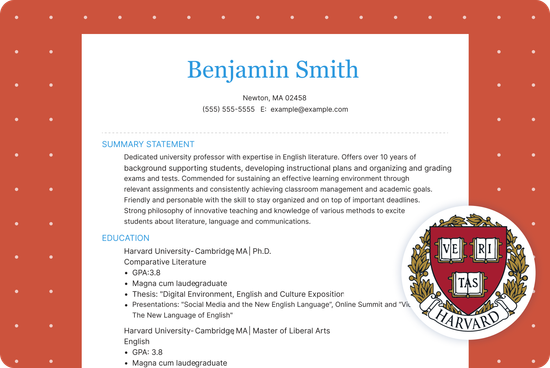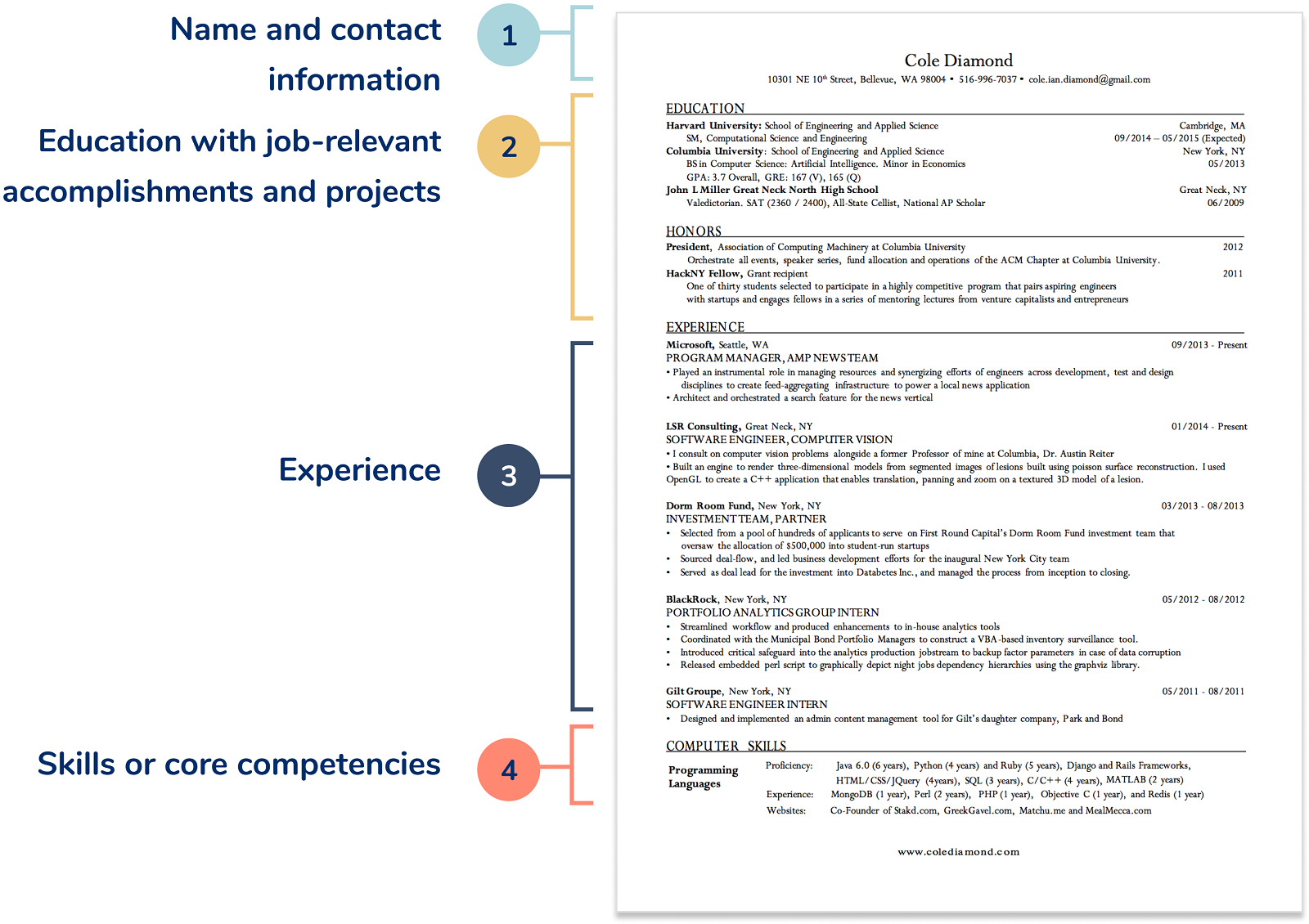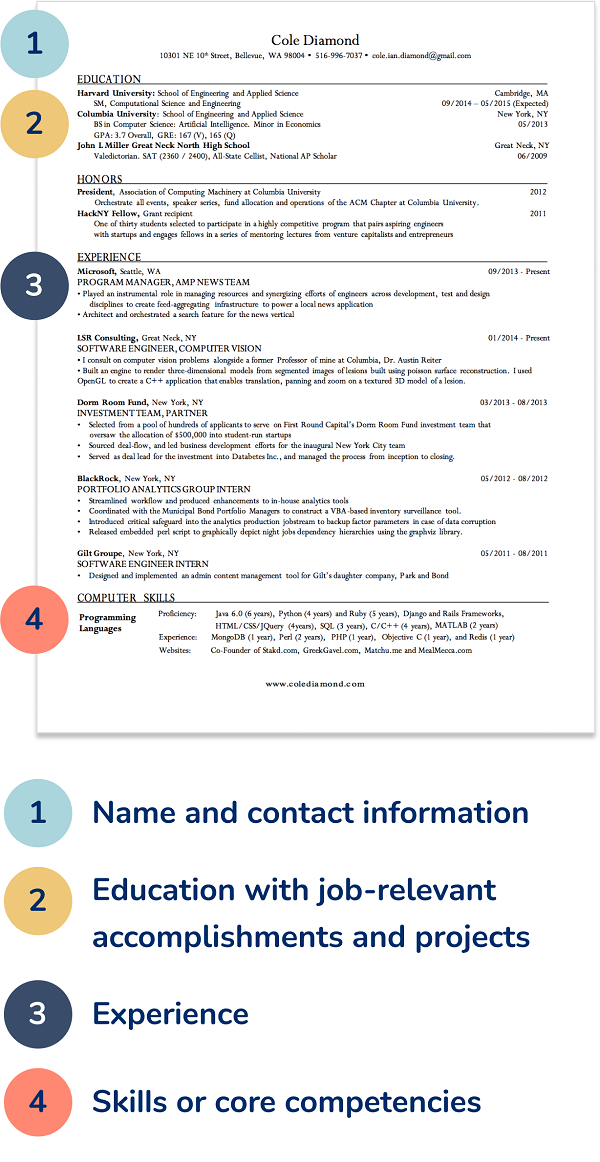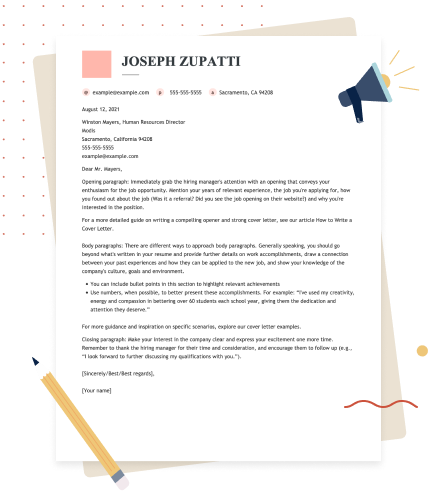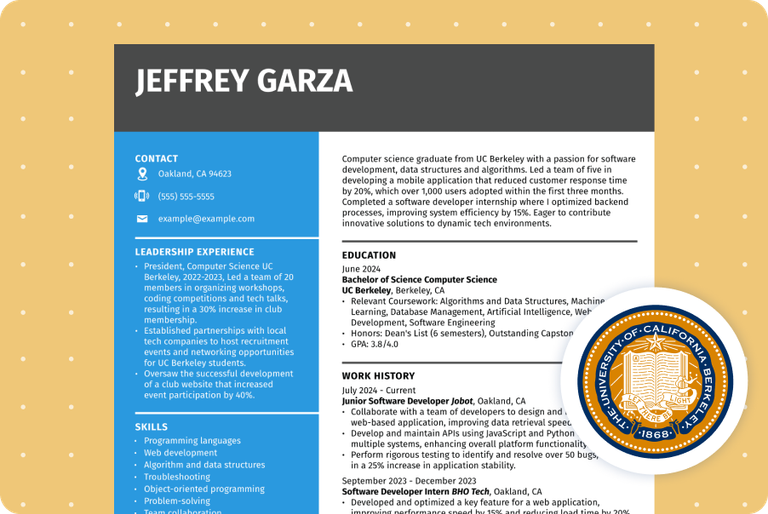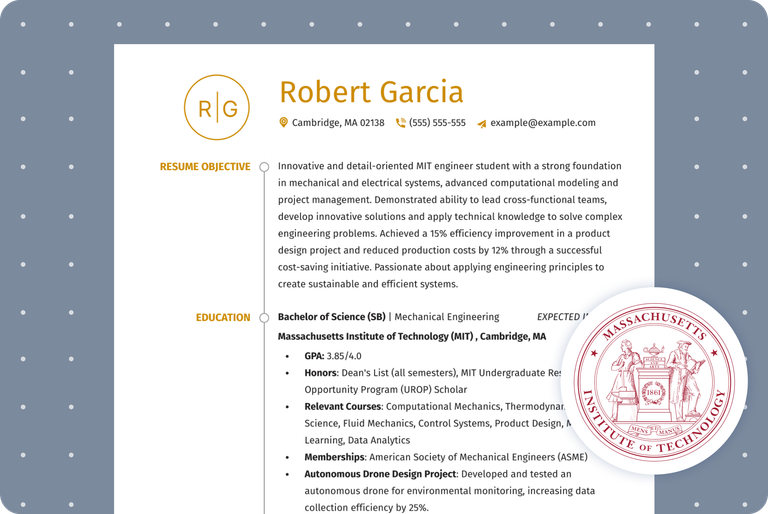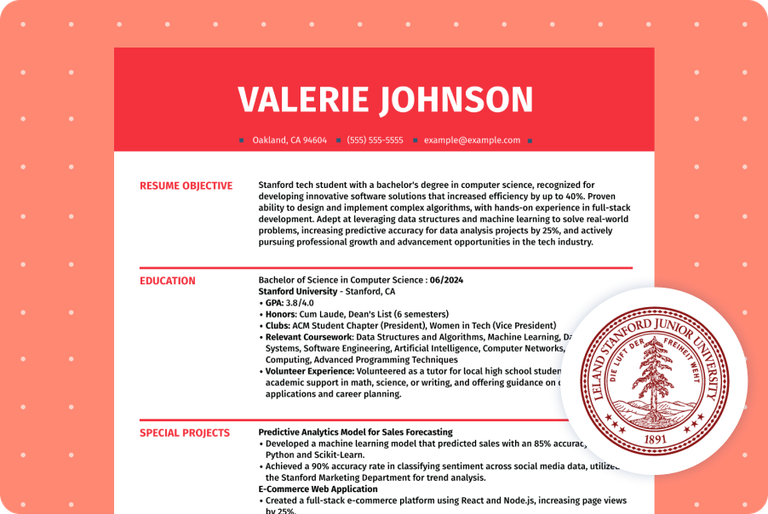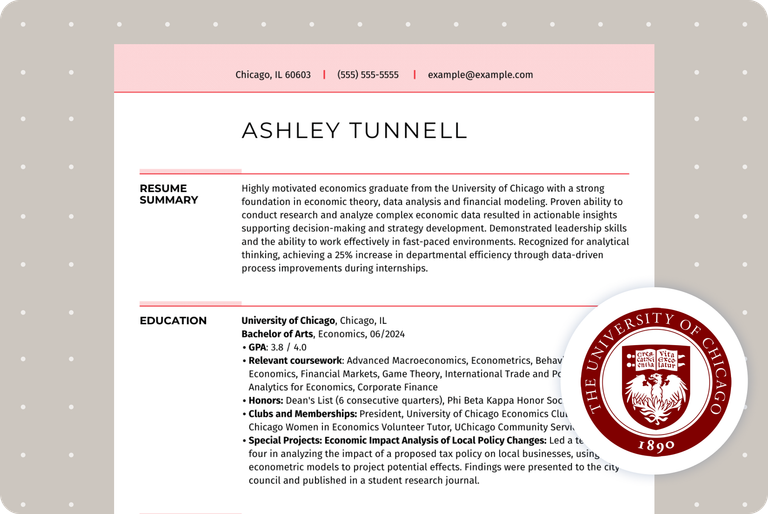Harvard Resume Template (Guide & Examples)

Our customers have been hired at: *Foot Note
Harvard University is one of the world’s top institutions of higher learning, known for its rigorous academic programs and exceptional graduates.
A well-written resume showcasing your time at this historic institution can help you stand out from the pool of applicants in any industry.
In this Harvard resume guide, we’ll show you how to craft each section of your resume and provide Harvard resume examples to help you get started.
What is the Harvard Resume Format?
The Harvard resume format is slightly different from traditional resume formats.
This type of resume organizes your information according to importance and what you want to bring to the recruiter's attention first, whether it is skills, experience or education.
It also follows standard formatting practices:
- 10-12 point font
- Margins between .5 and one inch
- Bullet points
- Bold text
- Italics to enhance readability.
The Harvard resume example below follows Harvard’s Mignone Center for Career Success Undergraduate Resource Series “Resumes & Cover Letters” guide. We’ve called out each section to indicate the crucial components of a compelling Harvard resume that wins interviews.
How to Structure Your Harvard Resume
Each section of your Harvard University resume plays a vital role in painting a compelling picture of who you are and what you can bring.
By carefully crafting each section, you can make the most out of your resume and stand out from the competition.
Let's explore how to write your perfect resume.
Craft a powerful resume summary
A resume summary is your introduction to the employer. It should pack a strong punch as this is the first section recruiters and hiring managers read.
Take an elevator pitch approach and include your strongest, job-relevant information.
Your Harvard resume’s summary statement should include the following:
- Years of experience
- Strongest job-relevant skills
- Important accomplishments
For example:
Highly motivated Harvard Law School graduate with a strong foundation in corporate law, litigation, and legal research. Adept at analyzing complex legal issues, drafting precise legal documents, and delivering persuasive arguments. Proven leadership through participation in moot court competitions and legal clinics, with a passion for driving impactful outcomes. Ready to contribute a fresh perspective and strong work ethic to a dynamic legal team.
If you recently graduated from Harvard and have little experience, use a resume objective instead.
Highlight your education
A Harvard-style resume features the academic background section prominently at the top of the resume.
Start with the university name. Below the name, write the degree, concentration and GPA (if it is above a 3.5).
Remember that your GPA is optional but can help you stand out from other candidates.
Under your school and degree, you can also include:
- Any honors, if applicable
- Job-relevant coursework
- Thesis
- Memberships to sports teams or clubs
For example:
HARVARD UNIVERSITY May 2023
A.B. Honors degree in Bioengineering. GPA 3.89
National Science Foundation Graduate Research Fellowship
Dean’s List
STUDY ABROAD June-July 2022
Study abroad coursework in Revolution in Biomedicine
Imperial College, London
Showcase your experience at Harvard
Follow a reverse chronological order when writing your Harvard work history section. Include any professional experience that prepared you for the role, whether on campus or off.
Write the company or institution's name, location, and employment dates. Use strong Harvard resume action verbs and try to incorporate quantifiable achievements to underscore your capacity to drive positive outcomes.
Here’s an example:
Legal Intern | Harrison & Klein LLP
Cambridge, MA | May 2023 – August 2023
- Drafted and reviewed 30+ contracts, legal memoranda, and pleadings, ensuring accuracy and compliance with state and federal regulations.
- Supported attorneys in mediation and settlement discussions for 5 client disputes, helping negotiate resolutions that saved clients an average of $50K in litigation costs.
- Participated in client intake processes, interviewing 15+ prospective clients and drafting case summaries to streamline onboarding.
If you have considerable experience in a specific field, use it as a section title on your Harvard resume to draw recruiters' eyes. For example, if you had a prolific career at The Crimson and have collaborated with other newsrooms and publications, create a Journalism Experience section.
Feature relevant skills
A well-written skills section featuring a balanced mix of sight to eight hard and soft skills is crucial to convincing employers you're the right candidate for the role.
Study the job description to identify the critical skills the hiring manager is looking for and include them in your Harvard resume.
If you wish to highlight a specific set of skills, separate them into sections: technical skills, languages and laboratory.
For example:
Technical skills: Data Visualization, Quantitative Analysis, Data Warehousing
Languages: English, Spanish, Conversational Portuguese, Basic French
If you have little work experience in your desired industry, focus on transferable skills demonstrating adaptability.
Include optional sections
Including additional sections, such as research experience or leadership experience, can broaden the scope of your resume and impress hiring managers.
Format this section the way you would your work history section. See how it might look:
Cambridge, MA | January 2023 – December 2023
- Led a team of 50+ writers, editors, and designers to publish 250+ articles weekly, maintaining a readership of 1M+ monthly visitors.
- Oversaw editorial strategy and content planning, increasing online engagement by 35% through investigative reporting, multimedia content, and timely news coverage.
- Organized and moderated five high-profile panel discussions with guest speakers, including national journalists and Harvard faculty, increasing event attendance by 40% year-over-year.
Harvard Resume Templates
See over 800+ resume examples for different jobs, industries, and career levels.
Create a Cover Letter to Match Your Harvard Resume
A cover letter is a one-page document that expands on your resume and allows you to explain how your skills and expertise align with the employer's needs.
Our Cover Letter Generator can help you craft a compelling letter with job-specific suggestions and professionally designed cover letter templates.
When writing your Harvard cover letter, follow the tips below:
- Use a traditional cover letter format.
- Keep it to one page.
- Establish a personal connection by addressing it directly to the hiring manager.
- Outline how your past professional experiences prepared you for this opportunity.
- End with a call to action.
Harvard Resume Tips
- Use keywords from the job description to tailor your Harvard resume and increase your chances of passing ATS.
- Select one of our resume templates with stacked sections to allow recruiters to skim through quickly.
- Scan your resume through our ATS resume checker to detect common resume errors and get actionable advice.
- Avoid “I” statements.
- Choose a professional and easy-to-read resume font.
- Use numbers to quantify your achievements and showcase how you’ve used your skills.
- Maintain consistent margins between 0.5 and one inch to ensure balanced white space.
FAQ
How should I display Harvard Extension School on my resume?
The Harvard Extension School is an important part of Harvard’s lineage. As part of its continuing education division, it provides a flexible education experience with the same access for remote, hybrid and on-site students.
Harvard Extension School should be displayed in your resume as follows:
Harvard University, Extension School
Master School of Liberal Arts, Economics
GPA 3.75
See our college student resume examples for additional guidance on crafting an effective student resume.
Can I put a Harvard online course on my resume?
Yes! Harvard encourages all its students to include their completed courses, certifications and degrees on a resume and professional profile. You can include a PDF link to the Course Verification Form as proof if you’re so inclined.
Explore our Google resume examples to see how you can tailor your Harvard resume for jobs with a specific employer.
Where to include GPA in Harvard resume?
When building a Harvard resume, your GPA, honors and test scores should always be included in the education section under the degree. If you also have an honor designation, include the GPA next to it.
For example:
Harvard University, Extension School
Bachelor of Liberal Arts, Field of Information Technology
Cum Laude, GPA 3.7
How to write a Harvard resume?
Before you start writing your resume, establish why you are building your Harvard resume. Is it for a job application? Internship? Postgraduate studies? Then, you can take a better approach to building your resume.
- For employment, focus on your job-relevant skills, experience and coursework.
- For postgraduate studies, focus on your academic experiences and coursework. See our student resume example guide.
- Choose a Harvard resume template.
Create a contact section with current information. - Build a summary statement to highlight your skills and experiences.
- Create a work section using action verbs to describe your achievements.
- Highlight your Harvard education by including your GPA and any awards.
- Use optional additional sections, like volunteer work and internships, to stand out from other applicants.
Explore our Yale resume templates for additional guidance on showcasing your education on your resume to stand out to employers.
What font size should I use in a Harvard-style resume?
The Office of Career Services at Harvard recommends using font sizes 10 to 12. To maintain a cohesive document package, you should also keep the same font and font size between your resume and cover letter.
Remember to keep the font size consistent. Your name should be the largest size, the section titles should be two points smaller than the name, and the section content should be no smaller than 10 points.
Should I use a CV or a resume?
Choosing a CV vs. a resume will depend on your career and the employer’s request. A CV is unlimited in length and provides a comprehensive look into your work, skills, and experiences. Meanwhile, a resume is a snapshot of your career in one or two pages.
A CV is mainly used for academic, medical, scientific and international careers and postgraduate studies. If you continue with higher education, confirm the school requirements for a CV or resume.
Our CV examples can help you learn more about creating your own. Once you’re ready, choose a CV template and head to our CV Maker to build a CV.
How we reviewed this article
Since 2012, we have helped more than 11 million job seekers. We want to make your career journey accessible and manageable through our services and Career Center’s how-to guides and tips. In our commitment to bring you a transparent process, we present our Editorial Process.
Sources
- Harvard University Mignone Center for Career Success. Undergraduate Resource Series. Harvard College Resumes & Cover Letter Guide
- Harvard University Graduate School of Design. Article. How to Write a Resume That Stands Out
- CNBC. Article. Mckissen, Dustin. An example of the perfect resume according to Harvard and career experts
- Harvard Business Review. Article. Gallo, Amy. How to Write a Resume That Stands Out
Our customers have been hired at:*Foot Note
